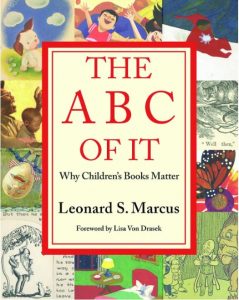The ABC Of It: Why Children’s Books Matter
 The ABC Of It: Why Children’s Books Matter
The ABC Of It: Why Children’s Books Matter
By: Leonard S. Marcus
Kerlan Collection at the University of Minnesota 2019 (240 pages)
Reviewed By: Amy Janczarek
In June 2013 , the exhibit, The ABC of It: Why Children’s Books Matter, opened at the New York Public Library. It would be the most highly attended exhibit in the history of the library, experiencing over half a million visitors over 14 months. It was so popular it was extended twice, eventually closing in September 2014.
Unique to most books, this is an overview of the exhibition comprised of gallery notes and short excerpts that offer insight into the ways in which children’s literature has evolved in purpose, societal impact, subject matter and its relationship to world cultures, bolstered by beautiful photos of the original works from the exhibit. This is essentially an exhibit catalog to the nth degree.
To be clear, this book is a vignette into the exhibit that captivated art and book lovers alike rather than offering a detailed and all-inclusive history of children’s literature. It will offer a curious mind a chance to experience a short history of children’s literature in hopes of sparking further inquiry into the multitude of fascinating aspects of the genre. When reading, one quickly realizes the history presented in this text can only be the tip of the iceberg so to speak. Your mind will race with questions and involuntarily start trying to make connections to the commentary and how your favorite childhood stories fit into the timelines presented in the exhibit.
Readers will have opportunity to reflect on the mindset of writers, educators and artists in relationship to what qualities constitute the best children’s books, from as early as the 1600’s through modern day. As the world met the challenges of war, immigration, industrialization, and even upward mobility, you can see the approaches to writing and illustrating of books changing in answer to these life altering experiences.
It also lauds the genius of the authors and artists instrumental in forging ahead as their audience widened from a time when illustrated texts were items to behold as gifts to upper class children to the time when children could afford to purchase literature on their own in the form of comics with their pocket change as well as making an effort to showcase different ethnicity and cultures that were out of the ordinary in comparison to the common white upper class characters traditionally seen in books.
Moreover, this book is an opportunity to relive the memories of your favorite childhood stories in a more historical and informed context which can only offer a deeper appreciation of where, as a reader, you’ve come.
